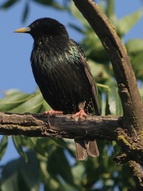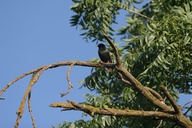The European starling, or sturnus vulgaris, was brought to North America in the very late 19th century by Eugene_Schieffelin, whose dream was to populate New York's Central Park with every bird species ever mentioned by Shakespeare. Scheiffelin released about 100 starlings into the park in the early 1890s. The starling flourished, and its spread across the United States was enabled by the construction of the interstate highway system in the 1950s — the new coast-to-coast medians provided the same sort of roadway for the starlings as it did for the Chevys.
The starling has presumably displaced many native bird species. The starling is omnivorous, eating seeds, berries, earthworms, beetles, and other foods. The bird often poses a problem to agricultural sites, and is also a known carrier of certain viruses and mites transmittable to humans. Some measures are taken to control the starling population, but certain control tactics are banned, though the bird goes unprotected by the U.S. Fish and Wildlife Dept.
The starling has been spotted around Putah Creek and other areas of Davis.





